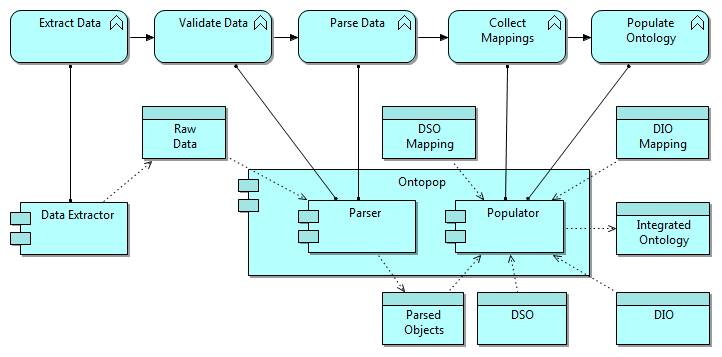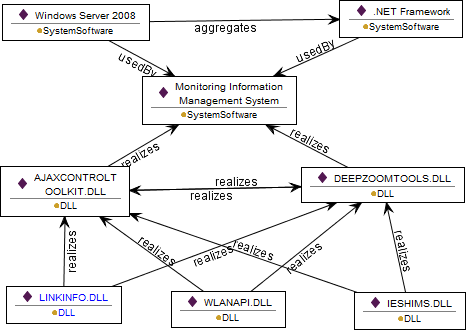In this section
TIMBUS Partners










Automating Context Model Integration
- Details
- Created on Thursday, 08 May 2014 09:25
- Last Updated on Tuesday, 21 October 2014 08:32
|
João Cardoso (INESC-ID), José Barateiro (LNEC) and Gonçalo Antunes (INESC-ID) "The integration of large models by humans is challenging, for it is a time-consuming and error-prone task." |
|
![]()
Digital preservation of business processes require a single, coherent and updated context model. This is especially relevant to support the decision about: "What to preserve?" and "How to preserve it?".
The TIMBUS context model is based on Enterprise Architecture principles, namely the Archimate EA modelling language. Both the core context and extensions are expressed in OWL. Different context and architectural models may hold concepts whose integration is required to create a single and coherent model. The integration of large models by humans is challenging, for it is a time-consuming and error-prone task that also entails issues in modelling correctness. In an effort to automate this task, an architecture and tool supporting the automatic integration of multiple model representations into a unified ontology model, named Ontopop, was developed.

Figure 1: The Ontopop Unified Ontology Model
Ontopop is extractor independent, i.e., it populates ontologies independently from the schema used to organise the data. Independence is achieved by resorting to the use a mapping's specification schema. This schema defines the mappings to establish relations between elements originated in the data extractors and the various classes defined in the Domain Specific Ontology (DSO), using those relations to create and populate the DSOs with individuals of such classes. Additionally, mappings to the Domain Independent Ontology (DIO) are also defined, so that the overall context model consistency is achieved.
Ontopop is composed of two primary modules, the Parser and the Populator, as represented in Figure 1. The Parser module allows the application to parse Raw Data outputted by the Data Extractor, regardless of the schema used for organising the data, by applying an adequate parser for every schema. The parsing process requires the data to be previously validated. Only then can it be processed into Parsed Objects. The Populator module is required to collect the mappings and populate the Integrated Ontology, and enters into play once the parsed data is produced. In order to populate the integrated ontology, the Populator module requires two different types of artefacts: Mappings (DSO Mapping and DIO Mapping) to correlate parsed data elements with ontology concepts, which must be collected before the integrated ontology is populated; and the Ontologies (DSO and DIO), which are referenced within the mappings (i.e. the DIO and DSOs), and needed so that new individuals can be integrated. Two distinct kinds of mapping are possible: DSO Mapping, whihc maps information regarding the Raw Data outputted by the extractors and the DSO classes, and DIO Mapping, which maps information regarding elements belonging to both the DSO and the DIO.
Ontopoop has already been used in one of the WP8 civil engineering scenarios to integrate human-modeled DIO with DSOs originated in the TIMBUS context extraction tools.

Figure 2: Excerpt of individuals belonging to the DIO and DSO integrated as a result of the Ontopop Implementation.
In this particular scenario, mappings were defined between the extracted elements and the classes of the DSOs, namely the DLL class in the Library DSO and the Package class in the Package DSO. As the extractors also outputted dependencies information, this information was also added with the creation of object properties relating the individuals.
Finally, mappings were also defined between elements of the DIO and elements in the DSO. In this case, the class Package was mapped into the class SystemSoftware in the DIO through a subclass assertion, and the class DLL was mapped into the class Artifact in the DIO, also through a subclass assertion. Then, the DSO individuals are integrated with the individuals contained in the DIO, in this case, through a realizes Object Property.
The Ontopop architecture uses the mappings to correlate the extracted elements and ontology concepts and populate an ontology with individuals. Figure 2 depicts an excerpt of individuals belonging to the DIO and DSO integrated as a result of the Ontopop implementation.
Although the tool was only texted in one of WP8's civil engineering scenarios, it can be used to handle the integration of large, volatile (i.e., frequently modified), heterogeneous, or even a combination of any of the three.




